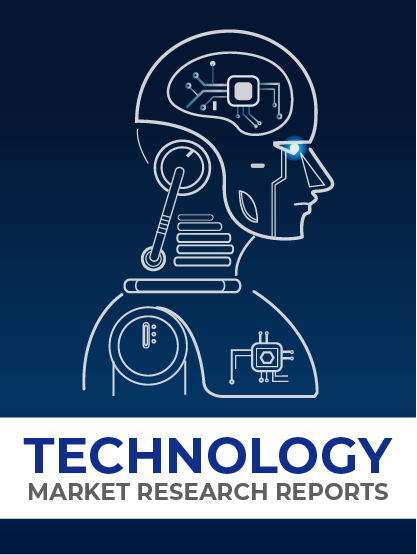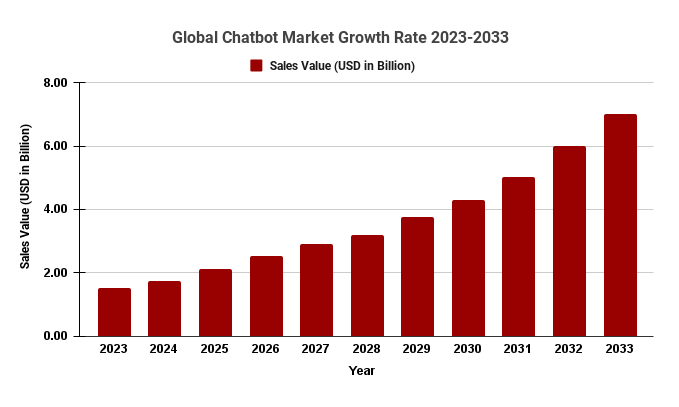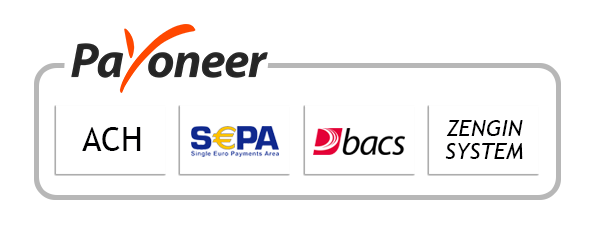
-
Report ID 138014 -
Published Date Mar 2023 -
Delivery Format PDF/PPT/Word -
Editor's Rating
-
Report Details
Chatbot Market Overview
The chatbot market refers to the market for AI-powered virtual assistants that interact with users through text or voice to provide information, answer questions, or perform various tasks. Chatbots are used across various industries, including retail, healthcare, finance, and telecommunications, to streamline customer support, enhance customer engagement, and improve operational efficiency. The chatbot market has witnessed significant growth in recent years due to the rapid advancements in AI, natural language processing (NLP), and machine learning technologies.
In 2022, the Chatbot Market size was valued at USD 4.92 billion. Between 2023 and 2032, this market is estimated to register the highest CAGR of 23.91%. It is expected to reach USD 42 billion in the forecast period.
Get a holistic overview of the market from industry experts to evaluate and develop growth strategies. Download the Sample

The increasing acceptance of customer service activities among businesses to reduce operating expenses is expected to boost market growth. A chatbot is a collaborative application programmed with artificial intelligence technology and specific set of rules designed for textual conversation with humans, integrated with various messaging facilities that support users across various sectors. With advances in artificial intelligence and machine learning technologies, demand for chatbots will only increase.
Factors driving the growth of the chatbot market include the rising demand for efficient and cost-effective customer support solutions, increasing adoption of AI and NLP technologies in chatbot development, growing need for personalized customer experiences, and expansion of messaging platforms and social media.
North America is the largest market for chatbots, followed by Europe and the Asia-Pacific region. The growth in these regions can be attributed to the high adoption rate of chatbot solutions across various industries, advanced technology infrastructure, and the presence of leading chatbot developers. The Asia-Pacific region, particularly countries like China, India, and Japan, is expected to be the fastest-growing market due to increasing adoption of advanced technologies, growing digitalization across industries, and rising demand for automation.
Demand Analysis
The demand for chatbots is driven by:
- The increasing need for efficient and cost-effective customer support solutions.
- The growing adoption of AI and NLP technologies in chatbot development.
- The rising demand for personalized customer experiences and marketing automation.
- The expansion of messaging platforms and social media, facilitating seamless integration of chatbots.
Top Key Trends
- The development of advanced AI and NLP technologies, enabling more natural and human-like interactions with chatbots.
- The increasing use of voice-based chatbots, powered by voice recognition and synthesis technologies.
- The integration of chatbots with IoT devices and smart home systems for improved user experiences and automation.
- The adoption of chatbots in various industries for diverse applications, such as customer support, sales, and internal processes.
Top Impacting Factors
- Rapid advancements in AI, NLP, and machine learning technologies.
- The growing demand for efficient and cost-effective customer support solutions.
- The increasing need for personalized customer experiences and marketing automation.
- The expansion of messaging platforms and social media integration.
Key Benefits for Stakeholders
- Chatbot developers and service providers can capitalize on the growing demand for chatbot solutions by expanding their offerings and continuously innovating their products.
- Businesses across various industries can benefit from chatbot implementation, improving customer engagement, streamlining customer support, and enhancing overall operational efficiency.
- Consumers can enjoy a more personalized and convenient experience when interacting with businesses through chatbots.
Market Dynamics
1. Drivers
– Rising demand for efficient and cost-effective customer support solutions.
– Increasing adoption of AI and NLP technologies in chatbot development.
– Growing need for personalized customer experiences and marketing automation.
– Expansion of messaging platforms and social media integration, facilitating chatbot adoption.2. Restraints
– Data privacy and security concerns associated with the use of chatbots.
– Limited understanding and adoption of chatbots in some industries.
– Potential loss of human touch in customer interactions due to chatbot usage.3. Opportunities
– Integration of chatbots with IoT devices and smart home systems for improved user experiences and automation.
– Development and adoption of voice-based chatbots, powered by voice recognition and synthesis technologies.
– Expansion of chatbot applications in various industries, including healthcare, education, and human resources.
– Partnerships between chatbot developers and businesses to create industry-specific chatbot solutions.4. Challenges
– Ensuring data privacy and security while handling sensitive user information.
– Developing chatbots with advanced natural language understanding capabilities to handle complex and diverse user interactions.
– Overcoming cultural and language barriers in the global chatbot market.
– Balancing automation and personalization with the need for human touch in customer interactions.Top Key Players
- [24]7. ai, Inc.
- Acuvate
- Aivo
- Artificial Solutions
- Botsify Inc.
- Creative Virtual Ltd.
- eGain Corporation
- IBM Corporation
- Inbenta Technologies Inc.
- Next IT Corp.
- Nuance Communications, Inc.
Market Segmentation
- Offering Outlook
- Solution
- Services
- Type Outlook
- Standalone
- Web-based
- Messenger-based/Third Party
- Medium Outlook
- Contact Centers
- Websites
- Social Media
- Mobile Applications
- Business function Outlook
- IT Services
- HR Services
- Sales & Marketing
- Finance
- Application Outlook
- Customer Services
- Branding & Advertising
- Personal Assistance
- Data Privacy & Compliance
- Payment Processing
- Others
- Vertical Outlook
- Healthcare
- Retail & E-commerce
- BFSI
- Media & Entertainment
- Travel & Tourism
- Transportation & Logistics
- Others
- Regional Outlook
- North America
- U.S.
- Canada
- Mexico
- Europe
- Germany
- U.K.
- Asia Pacific
- China
- Japan
- South Korea
- South America
- Brazil
- MEA
- North America
-
Table Of Content
Research Insights & Deliverables
 Development and Future Forecast
Development and Future Forecast Competitive benchmarking
Competitive benchmarking Company Revenue Statistics
Company Revenue Statistics Rising Regional Opportunities
Rising Regional Opportunities Technology Trends and Dynamics
Technology Trends and Dynamics Technology Assessment
Technology Assessment
-
Inquiry Before Buying
Research Insights & Deliverables
 Development and Future Forecast
Development and Future Forecast Competitive benchmarking
Competitive benchmarking Company Revenue Statistics
Company Revenue Statistics Rising Regional Opportunities
Rising Regional Opportunities Technology Trends and Dynamics
Technology Trends and Dynamics Technology Assessment
Technology Assessment
-
Request Sample
Research Insights & Deliverables
 Development and Future Forecast
Development and Future Forecast Competitive benchmarking
Competitive benchmarking Company Revenue Statistics
Company Revenue Statistics Rising Regional Opportunities
Rising Regional Opportunities Technology Trends and Dynamics
Technology Trends and Dynamics Technology Assessment
Technology Assessment














